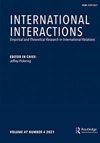Forecasting change in conflict fatalities with dynamic elastic net
IF 1.4
3区 社会学
Q2 INTERNATIONAL RELATIONS
引用次数: 3
Abstract
Abstract This article illustrates an approach to forecasting change in conflict fatalities designed to address the complexity of the drivers and processes of armed conflicts. The design of this approach is based on two main choices. First, to account for the specificity of conflict drivers and processes over time and space, we model conflicts in each individual country separately. Second, we draw on an adaptive model—Dynamic Elastic Net, DynENet—which is able to efficiently select relevant predictors among a large set of covariates. We include over 700 variables in our models, adding event data on top of the data features provided by the convenors of the forecasting competition. We show that our approach is suitable and computationally efficient enough to address the complexity of conflict dynamics. Moreover, the adaptive nature of our model brings a significant added value. Because for each country our model only selects the variables that are relevant to predict conflict intensity, the retained predictors can be analyzed to describe the dynamic configuration of conflict drivers both across countries and within countries over time. Countries can then be clustered to observe the emergence of broader patterns related to correlates of conflict. In this sense, our approach produces interpretable forecasts, addressing one key limitation of contemporary approaches to forecasting.用动态弹性网预测冲突死亡人数的变化
摘要本文阐述了一种预测冲突死亡人数变化的方法,旨在解决武装冲突驱动因素和过程的复杂性。这种方法的设计基于两个主要选择。首先,为了说明冲突驱动因素和过程在时间和空间上的特殊性,我们分别对每个国家的冲突进行了建模。其次,我们利用了一个自适应模型——动态弹性网,DynNet——它能够在一大组协变量中有效地选择相关的预测因子。我们在模型中包含了700多个变量,在预测竞赛召集人提供的数据特征的基础上添加了事件数据。我们证明了我们的方法是合适的,并且计算效率足够高,可以解决冲突动力学的复杂性。此外,我们模型的适应性带来了显著的附加值。因为对于每个国家,我们的模型只选择与预测冲突强度相关的变量,所以可以分析保留的预测因子,以描述国家间和国家内冲突驱动因素随时间的动态配置。然后可以将各国聚集在一起,观察与冲突相关的更广泛模式的出现。从这个意义上说,我们的方法产生了可解释的预测,解决了当代预测方法的一个关键局限性。
本文章由计算机程序翻译,如有差异,请以英文原文为准。
求助全文
约1分钟内获得全文
求助全文
来源期刊

International Interactions
INTERNATIONAL RELATIONS-
CiteScore
2.40
自引率
7.70%
发文量
38
期刊介绍:
International Interactions is a leading interdisciplinary journal that publishes original empirical, analytic, and theoretical studies of conflict and political economy. The journal has a particular interest in research that focuses upon the broad range of relations and interactions among the actors in the global system. Relevant topics include ethnic and religious conflict, interstate and intrastate conflict, conflict resolution, conflict management, economic development, regional integration, trade relations, institutions, globalization, terrorism, and geopolitical analyses.
 求助内容:
求助内容: 应助结果提醒方式:
应助结果提醒方式:


